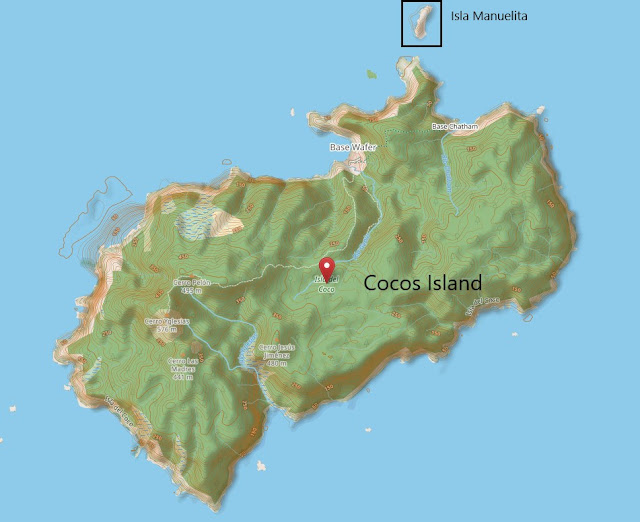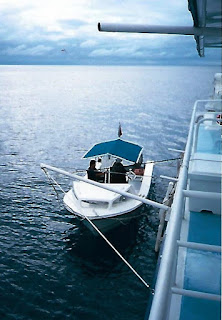I am preparing a series of stories of people who find themselves adrift in the water. The first story comes from an incident that occured in August 2002 whlile I was on the live aboard diveboat, the Undersea Hunter, in August 2002. It is purely coincidental that this story appears on Mother's Day 2024.
To say that Cocos Island, Costa Rica, in the Pacific Ocean, is "isolated" is an understatement. The island, designated Cocos Island National Park, lies approximately 340 miles southwest of the Costa Rican mainland. “Middle of nowhere” barely begins to describe
this location. Just getting to the island required a 30+ hour boat ride from
Punta Arenas on board Undersea Hunter—a
top live-aboard dive boat. I was
traveling with a group organized by Brandon and Melissa Cole. Our group claimed many of the available
spaces on the boat; others took the rest.
I had prepared for the remoteness of the location by
incorporating into my dive gear, in addition to the whistle permanently affixed
to my buoyancy compensator, an extremely loud surface signaling device powered
by the compressed air (from my tank), a bright green surface marker buoy, a
flashing strobe light and a signal mirror.
I had considered a bright green dye marker pack, but the container could
not sustain the pressure of deep water immersion without hemorrhaging the dye.
Diving
Safety Briefing
The first predive briefing of the trip, held prior to our
first dive, emphasized the conservation orientation of the operators at Cocos
Island and what a privilege it was to dive in this unique marine wilderness. (Only park personnel and scientific
researchers are allowed on shore.) The “boat rules” include no intentional
interaction with the fish, no feeding of fish, no manta riding, and no pulling
the shark’s tail. One would think these
rules need not be explicitly stated given the conservation ethic of
diving. My observation of diver
behaviors over the years is to the contrary.
When in doubt, point it out.
The second half of the briefing emphasized safety and the
need to follow the diving protocols. Divers
were directed not to exceed the 130 foot depth limit. The briefer noted that divers were
responsible for knowing and not exceeding their individual “no decompression
limits. Other protocols emphasized the
need to maintain visual contact with the underwater walls. Also, since the dive spots are fairly deep,
the divemaster highlighted the need to complete the safety stop for three
minutes between 15 and 20 feet during ascent with one exception.
“No blue water diving!” the divemaster stressed. “If you
cannot see the wall or if you are in a strong current; do not do the
three-minute safety stop! Surface immediately, inflate your bc and marker buoy and the tender
will pick you up. The current will carry
you away from the island and the nearest landfall Is Antarctica.” It is a lesson we learned later that day.
The
Second Dive
Our second dive ended as a cautionary tale about diving
in the current. We planned to drop in on
the southwest side of Isla Manuelita, and descend as a group along the step
down slope to between 60 and 100 feet, while moving north. The orientation to do that is to keep the wall
on the right hand side. We would round the end of the islet and be picked up on
the northeast side.
After a routine descent, the divers wedged themselves
into a ledge along the wall to await the appearance of hammerhead sharks. I ascended a bit to address an issue and
found myself surrounded by fish. I could
not get back to the main part of the group as I was up current of their
location. Rather than fight against the current, I continued the dive. I had done a number of drift dives over the
years so I was comfortable doing so. The
current pushed me along the wall. I am able to maintain visual contact with the
wall. I start my ascent upon reaching my
“low air” tank pressure of 700 psi. After completing the three-minute safety
stop, I surface. The panga motored over
to retrieve me, as the current kept me from swimming to it. I am the first one on board.
Mom
goes adrifting
The group had spread out along the wall, with the
photographers bringing up the rear. As
the panga retrieved the divers, a diver returned onboard without her
buddy. The buddy pair, a mother-daughter
duo, is missing the mom. The daughter
reports that they were in a current as they ascended. The mom was carried out into blue water and
continued with the safety stop while the daughter surfaced. She did not see her mother surface.
A search immediately commenced. We cruised along the current line looking for
any sign of the diver, but we found nothing.
Visibility decreased as a squall line moved into the area. The divemaster’s initial look of optimism at
finding her quickly changed to one of consternation. He alerts the mothership by radio to dispatch
the second panga to join the search as soon as their divers are recovered. The Park Ranger from the island joined the
effort from his skiff.
Time passed. All
eyes on our panga desperately scan the water for a sign of the diver. We searched for what seems like an eternity
moving back and forth along the current line.
Suddenly, the radio sounded. The
other tender reports they have recovered the diver on the surface. We race over to their location, relieved that
the mother is OK.
Back on board the Undersea Hunter, the divemaster asked the
mother what happened. She replied,
“since it was a deep dive, I felt making the safety stop for the three full
minutes was very important.” She insisted
that nothing was wrong, seemed unfazed by the whole experience and appeared oblivious
to how close she came to going missing.
After a discussion that focused on the critical importance of directly
surfacing when in blue water, the incident is closed. But, the lesson stayed with us for the rest
of the dives.




No comments:
Post a Comment